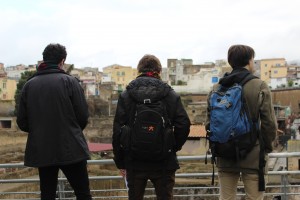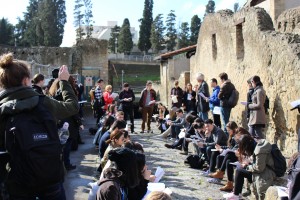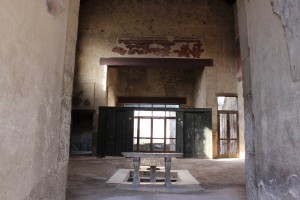
This past weekend I visited a city unearthed. What was originally a city by the sea shaped by Etruscan, Greek, and Samnite influences is now a site straddling a 25 meter high mound of 1,935-year-old pyroclastic flow and the Gulf of Naples. Because of the nature of the pyroclastic surges (there were six!), Herculanium’s organic materials were carbonized and the city’s structural elements are more visible than those of Pompeii. Like pioneers of an alien city, we entered the houses and political edifices that stood bruised but not yet broken before us.
The citizens of Herculaneum were wealthy, or so it seemed– in 79 AD Herculanians were residing in what was then a sleepy beach town. Within each house, you could see a trend; the front door, which abutted one of the few axial stone streets, was flanked by shops rented out by the homeowner. After moving past the entry vestibule, you’d emerge in the central atrium, which would house the water collection system, and allow entry into the bedrooms of the house. Just past the atrium, moving forward still, you’d hit the tablinum, which is essentially a boasting room; the family would display portraits and other valuable status symbols.
Past the tablinum is the garden and other private rooms like the dining room and rooms to receive guests. But wait, you ask, Isn’t the atrium private too? Isn’t a house private, Angela? Well, the answer is no… not entirely. The Herculaneum home was in part, public! Anyone could come into your atrium during certain hours of the day and hang out and talk politics. The home’s form and function is not only to house but to exhibit and schmooze. Pretty cool stuff. And of course we moseyed through some bath complexes which were mind-blowingly engineered with hollow tiles, bronze tubs, you name it! If you ever get a chance, visit Herculaneum. Your soul and sketchbook will be stuffed and elated.


